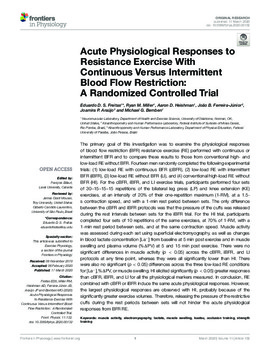| dc.contributor.author | Freitas, Eduardo D.S. | |
| dc.contributor.author | Miller, Ryan M. | |
| dc.contributor.author | Heishman, Aaron D. | |
| dc.contributor.author | Ferreira-Júnior, João B. | |
| dc.contributor.author | Araújo, Joarmira P. | |
| dc.contributor.author | Bemben, Michael G. | |
| dc.date.accessioned | 2020-03-23T20:53:26Z | |
| dc.date.available | 2020-03-23T20:53:26Z | |
| dc.date.issued | 2020-03-17 | |
| dc.identifier.citation | Freitas EDS, Miller RM, Heishman AD, Ferreira-Júnior JB, Araújo JP and Bemben MG (2020) Acute Physiological Responses to Resistance Exercise With Continuous Versus Intermittent Blood Flow Restriction: A Randomized Controlled Trial. Front. Physiol. 11:132. doi: 10.3389/fphys.2020.00132 | en_US |
| dc.identifier.uri | https://hdl.handle.net/11244/323813 | |
| dc.description.abstract | The primary goal of this investigation was to examine the physiological responses of blood flow restriction (BFR) resistance exercise (RE) performed with continuous or intermittent BFR and to compare these results to those from conventional high- and low-load RE without BFR. Fourteen men randomly completed the following experimental trials: (1) low-load RE with continuous BFR (cBFR), (2) low-load RE with intermittent BFR (iBFR), (3) low-load RE without BFR (LI), and (4) conventional high-load RE without BFR (HI). For the cBFR, iBFR, and LI exercise trials, participants performed four sets of 30–15–15–15 repetitions of the bilateral leg press (LP) and knee extension (KE) exercises, at an intensity of 20% of their one-repetition maximum (1-RM), at a 1.5-s contraction speed, and with a 1-min rest period between sets. The only difference between the cBFR and iBFR protocols was that the pressure of the cuffs was released during the rest intervals between sets for the iBFR trial. For the HI trial, participants completed four sets of 10 repetitions of the same exercises, at 70% of 1-RM, with a 1-min rest period between sets, and at the same contraction speed. Muscle activity was assessed during each set using superficial electromyography, as well as changes in blood lactate concentration [La–] from baseline at 5 min post exercise and in muscle swelling and plasma volume (%ΔPV) at 5 and 15 min post exercise. There were no significant differences in muscle activity (p < 0.05) across the cBFR, iBFR, and LI protocols at any time point, whereas they were all significantly lower than HI. There were also no significant (p < 0.05) differences across the three low-load RE conditions for [La–],%ΔPV, or muscle swelling. HI elicited significantly (p < 0.05) greater responses than cBFR, iBFR, and LI for all the physiological markers measured. In conclusion, RE combined with cBFR or iBFR induce the same acute physiological responses. However, the largest physiological responses are observed with HI, probably because of the significantly greater exercise volumes. Therefore, releasing the pressure of the restrictive cuffs during the rest periods between sets will not hinder the acute physiological responses from BFR RE. | en_US |
| dc.description.sponsorship | Financial support was provided from the Office of the Vice President for Research and Partnerships and the Office of the Provost, University of Oklahoma. Open Access fees paid for in whole or in part by the University of Oklahoma Libraries. | en_US |
| dc.language | en_US | en_US |
| dc.rights | Attribution 4.0 International | * |
| dc.rights.uri | https://creativecommons.org/licenses/by/4.0/ | * |
| dc.subject | muscle activity | en_US |
| dc.subject | electromyography | en_US |
| dc.subject | lactate | en_US |
| dc.subject | muscle swelling | en_US |
| dc.subject | kaatsu | en_US |
| dc.subject | occlusion training | en_US |
| dc.subject | strength training | en_US |
| dc.title | Acute Physiological Responses to Resistance Exercise With Continuous Versus Intermittent Blood Flow Restriction A Randomized Controlled Trial | en_US |
| dc.type | Article | en_US |
| dc.description.peerreview | Yes | en_US |
| dc.identifier.doi | 10.3389/fphys.2020.00132 | en_US |
| ou.group | College of Arts and Sciences::Department of Health and Exercise Science | en_US |

